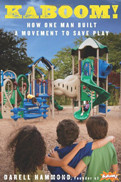“We don’t stop playing because we grow old, we grow old because we stop playing,” observed George Bernard Shaw. But what happens when children themselves play less? Today, electronic media dominate kids’ attention, helicopter parents curb exploratory free-range play, and space for outdoor play is diminishing. Darell Hammond founded KaBOOM!—a national nonprofit that provides communities with resources and guidance to build playgrounds—to reduce what he calls the “play deficit.” His book tells an uplifting story about how he took the organization to scale and matured as a manager, advocate, and leader.
KaBOOM! connects dollars and volunteers from corporations, such as Target, Snapple, and Home Depot, with communities in need to rally around a single tangible goal: the building of a kid-designed playground in one day. Community members and volunteers get to see the fruits of their labor right away (hence, KaBOOM!), creating an “achievable win,” as Hammond calls it, and a vivid sense of potential. During the past 15 years, KaBOOM! has been one of the fastest growing nonprofits in the United States. It now has an annual operating budget of more than $20 million. It has raised more than $200 million and harnessed a million volunteers to create more than 2,000 playgrounds primarily in low-income communities, a remarkable track record.
Hammond’s account of his emergence as a passionate and visionary social entrepreneur is inspiring. After growing up in a group home and dropping out of college, he describes how he found his calling in the service movement. He developed KaBOOM!’s innovative program and business model, established an upbeat organizational culture, instituted quality control standards for program replication, and nurtured the organization’s expansion. He reveals how he learned to delegate, and he refreshingly admits to just “winging it” at times and making some pretty big managerial mistakes. Hammond describes how he “turned a mission into a movement” by increasing advocacy efforts and freely sharing tools and expertise through online social networks to enable others to construct more than 1,600 do-it-yourself playgrounds.
Hammond identifies “cascading transformative change” in communities as KaBOOM!’s intended impact and writes that “we measure our success by looking at what happens after we leave.” He notes that an impressive 86 percent of the sites are maintained and that the planning and building process helps foster stronger communities. His point is that it matters how children use the playground and how community members continue the momentum and join forces to organize other efforts. Yet most of the evidence in the book about KaBOOM!’s longer term social impact is anecdotal. The statistics on outputs and the stories about positive community change are compelling, but the book would be even richer with more thorough documentation.
Hammond writes that “no single individual or organization can do enough on its own” and praises his senior team, board chairs, and other groups. Nevertheless, the story would have benefited from more detail about and insights into how the board and executive staff shared leadership and worked to make tough decisions, set priorities, and allocate scarce resources. Likewise, Hammond says little about co-founder Dawn Hutchison, the unfolding of their respective roles, and her departure from the organization. More also could have been written about how KaBOOM! has participated in coalitions with other leading organizations in the field, such as Playworks, which sends trained play coaches to urban low-income schools. The book’s subtitle—How One Man Built a Movement to Save Play—is individualistic, not collective.
Hammond makes a strong case that play is a necessity, not a luxury. While reading the book, I took a walk in a neighborhood outside of Detroit at sunrise, while children were still asleep. I noticed a nice playground that had a sandbox full of shovels, pails, and toy trucks. The kids in the community had not taken their playthings home, but left them there as a shared resource—the essence of social capital. Later that day, the playground was bustling with children who were exploring, sharing, refereeing, engaging, and inventing. Hammond explains how play teaches children how to practice adult roles. It enhances cognitive and physical development, creativity, and cooperation. And it helps prevent childhood obesity.
This book goes beyond children’s play. By reading it, social entrepreneurs and nonprofit leaders, along with the funders, investors, and advisors who support them, will get some solid, practical advice about how to grow a social enterprise, adapt programs and operations along the way, and amplify impact.
Paul Connolly is chief client service officer of TCC Group, a management consulting fi rm that provides strategy, evaluation, and capacity-building services to foundations, nonprofit organizations, and corporate community involvement programs.


